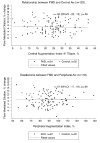Characterizing the relationship between flow-mediated vasodilation and radial artery tonometry in peripheral artery disease
- PMID: 29506827
- PMCID: PMC5844355
- DOI: 10.1016/j.jss.2017.11.062
Characterizing the relationship between flow-mediated vasodilation and radial artery tonometry in peripheral artery disease
Abstract
Background: Arterial stiffness, measured by the augmentation index (AIX) from radial artery tonometry, and endothelial dysfunction, measured by brachial-artery flow-mediated vasodilation (FMD), have each been associated with increased risk of cardiovascular events. However, their interrelationship in peripheral artery disease (PAD) patients is poorly understood.
Materials and methods: In a cross-sectional analysis of 123 vascular surgery outpatients, the association between FMD and AIX was examined in controls with atherosclerotic risk factors (n = 32) and patients with PAD (n = 91). PAD was defined as claudication symptoms with an ankle-brachial index of <0.9 or a history of revascularization for symptomatic PAD. Controls had an ankle-brachial index ≥0.9 and no history of atherosclerotic vascular disease.
Results: Compared to controls, patients with PAD had lower FMD (6.3 ± 3.8 versus 8.4 ± 3.7, P = 0.008), while central AIX normalized to 75 beats per minute (25.5 ± 9.0 versus 19.3 ± 8.6, P = 0.001) and peripheral AIX (91.3 ± 14.5 versus 81.3 ± 11.4, P = 0.001) were higher. FMD was not significantly correlated with either central or peripheral AIX (central AIX: P = 0.58; peripheral AIX: P = 0.89) across the entire cohort, or in either the patients with PAD (central AIX: P = 0.48; peripheral AIX: P = 0.23) or controls (central AIX: P = 0.43; peripheral AIX: P = 0.92). In a multivariate model including FMD, higher AIX remained independently associated with PAD.
Conclusions: In an analysis of vascular surgery outpatients, no correlation between FMD and AIX was detected. Larger prospective studies are needed to determine whether the inclusion of both parameters improves predictive models for the early identification and potential risk stratification of PAD patients.
Keywords: Arterial stiffness; Endothelial function; Flow-mediated vasodilation; Peripheral artery disease; Radial artery tonometry.
Published by Elsevier Inc.
Conflict of interest statement
Figures


References
-
- Fowkes FGR, Rudan D, Rudan I, et al. Comparison of global estimates of prevalence and risk factors for peripheral artery disease in 2000 and 2010: a systematic review and analysis. The Lancet. 2013;382:1329–1340. DOI: //dx.doi.org/10.1016/S0140-6736(13)61249-0. - DOI - PubMed
-
- Agarwal S, Sud K, Shishehbor MH. Nationwide Trends of Hospital Admission and Outcomes Among Critical Limb Ischemia Patients: From 2003–2011. Journal of the American College of Cardiology. 2016;67:1901–1913. DOI: //dx.doi.org/10.1016/j.jacc.2016.02.040. - DOI - PubMed
-
- Criqui MH, Ninomiya JK, Wingard DL, et al. Progression of Peripheral Arterial Disease Predicts Cardiovascular Disease Morbidity and Mortality. Journal of the American College of Cardiology. 2008;52:1736–1742. DOI: https://doi.org/10.1016/j.jacc.2008.07.060. - DOI - PMC - PubMed
Publication types
MeSH terms
Grants and funding
LinkOut - more resources
Full Text Sources
Other Literature Sources
Medical

